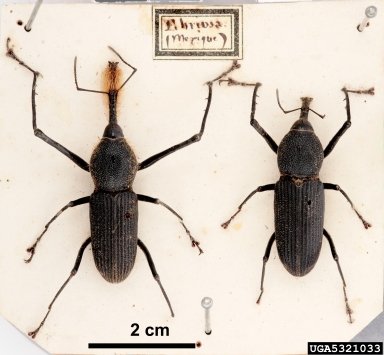
The South American Palm weevil can infest healthy, undamaged palms. Larvae often destroy the apical growth area of the tree by feeding on the growing tissue in the palm crown. Infested palms can eventually die; larvae are able to kill an adult coconut palm. Economic damage is dependent on both the species of palm and the number of larvae present. In addition to directly damaging plant tissue, R . palmarum is the vector of the nematode Bursap helenchus cocophilus. Bursaphelenchus cocophilus is the causal agent of the red-ring disease, which causes serious economic losses in palm plantations in South and Central America.

Identification:
Adults: The adult is a deep black color. The body surface is deeply pitted and is covered with short hairs. The insect has a sheen at emergence. The insect then assumes a dull black color for most of its adult life. The males are readily distinguished from the females by the presence of a “comb” of hairs on the proboscis.

References:
NAPPO Phytosanitary Alert System. Accessed 8/3/2015: http://www.pestalert.org/oprDetail.cfm?oprID=626
Poplin, A., A. Roda, S. Bhotika, and L. Sobel. 2014. Palm Weevils. Collaborative and Enhanced First Detector Training for Florida. http://www.flfirstdetector.org/ . Scripted PDF and PowerPoint Presentation for Educators. 33 slides. (August 11, 2015).
USDA-APHIS-PPQ Rhynchophorus palmarum. Accessed 8/3/2015: https://www.aphis.usda.gov/plant_health/plant_pest_info/palmweevil/downloads/Rhynchophoruspalmarum.pdf
 0
0
